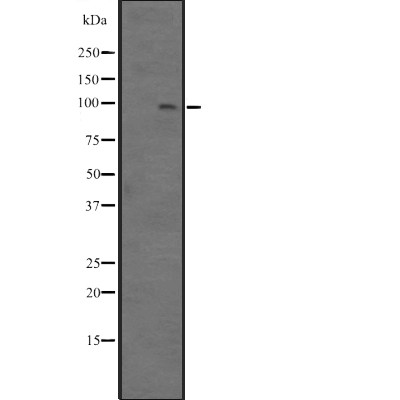BCL11B Antibody - #DF2464
| Product: | BCL11B Antibody |
| Catalog: | DF2464 |
| Description: | Rabbit polyclonal antibody to BCL11B |
| Application: | WB IHC IF/ICC |
| Reactivity: | Human, Rat |
| Prediction: | Pig, Bovine, Sheep, Dog, Chicken, Xenopus |
| Mol.Wt.: | 95 kDa; 96kD(Calculated). |
| Uniprot: | Q9C0K0 |
| RRID: | AB_2839670 |
Related Downloads
Protocols
Product Info
*The optimal dilutions should be determined by the end user. For optimal experimental results, antibody reuse is not recommended.
*Tips:
WB: For western blot detection of denatured protein samples. IHC: For immunohistochemical detection of paraffin sections (IHC-p) or frozen sections (IHC-f) of tissue samples. IF/ICC: For immunofluorescence detection of cell samples. ELISA(peptide): For ELISA detection of antigenic peptide.
Cite Format: Affinity Biosciences Cat# DF2464, RRID:AB_2839670.
Fold/Unfold
ATL1 alpha; ATL1; ATL1 beta; ATL1 gamma; ATL1-delta; B cell CLL/lymphoma 11B/T cell receptor delta constant region fusion protein; B cell lymphoma/leukemia 11B; B-cell CLL/lymphoma 11B (zinc finger protein); B-cell CLL/lymphoma 11B; B-cell lymphoma/leukemia 11B; BC11B_HUMAN; BCL-11B; Bcl11b; BCL11B/TRDC fusion; COUP TF interacting protein 2; COUP-TF interacting protein 2; COUP-TF-interacting protein 2; Ctip 2; CTIP-2; CTIP2; hRIT1 alpha; hRit1; Radiation induced tumor suppressor gene 1; Radiation induced tumor suppressor gene 1 protein; Radiation-induced tumor suppressor gene 1 protein; Rit 1; Rit1; zinc finger protein hRit1 alpha; ZNF856B;
Immunogens
A synthesized peptide derived from human BCL11B, corresponding to a region within the internal amino acids.
Highly expressed in brain and in malignant T-cell lines derived from patients with adult T-cell leukemia/lymphoma.
- Q9C0K0 BC11B_HUMAN:
- Protein BLAST With
- NCBI/
- ExPASy/
- Uniprot
MSRRKQGNPQHLSQRELITPEADHVEAAILEEDEGLEIEEPSGLGLMVGGPDPDLLTCGQCQMNFPLGDILVFIEHKRKQCGGSLGACYDKALDKDSPPPSSRSELRKVSEPVEIGIQVTPDEDDHLLSPTKGICPKQENIAGPCRPAQLPAVAPIAASSHPHSSVITSPLRALGALPPCLPLPCCSARPVSGDGTQGEGQTEAPFGCQCQLSGKDEPSSYICTTCKQPFNSAWFLLQHAQNTHGFRIYLEPGPASSSLTPRLTIPPPLGPEAVAQSPLMNFLGDSNPFNLLRMTGPILRDHPGFGEGRLPGTPPLFSPPPRHHLDPHRLSAEEMGLVAQHPSAFDRVMRLNPMAIDSPAMDFSRRLRELAGNSSTPPPVSPGRGNPMHRLLNPFQPSPKSPFLSTPPLPPMPPGGTPPPQPPAKSKSCEFCGKTFKFQSNLIVHRRSHTGEKPYKCQLCDHACSQASKLKRHMKTHMHKAGSLAGRSDDGLSAASSPEPGTSELAGEGLKAADGDFRHHESDPSLGHEPEEEDEEEEEEEEELLLENESRPESSFSMDSELSRNRENGGGGVPGVPGAGGGAAKALADEKALVLGKVMENVGLGALPQYGELLADKQKRGAFLKRAAGGGDAGDDDDAGGCGDAGAGGAVNGRGGGFAPGTEPFPGLFPRKPAPLPSPGLNSAAKRIKVEKDLELPPAALIPSENVYSQWLVGYAASRHFMKDPFLGFTDARQSPFATSSEHSSENGSLRFSTPPGDLLDGGLSGRSGTASGGSTPHLGGPGPGRPSSKEGRRSDTCEYCGKVFKNCSNLTVHRRSHTGERPYKCELCNYACAQSSKLTRHMKTHGQIGKEVYRCDICQMPFSVYSTLEKHMKKWHGEHLLTNDVKIEQAERS
Predictions
Score>80(red) has high confidence and is suggested to be used for WB detection. *The prediction model is mainly based on the alignment of immunogen sequences, the results are for reference only, not as the basis of quality assurance.
High(score>80) Medium(80>score>50) Low(score<50) No confidence
Research Backgrounds
Key regulator of both differentiation and survival of T-lymphocytes during thymocyte development in mammals. Essential in controlling the responsiveness of hematopoietic stem cells to chemotactic signals by modulating the expression of the receptors CCR7 and CCR9, which direct the movement of progenitor cells from the bone marrow to the thymus. Is a regulator of IL2 promoter and enhances IL2 expression in activated CD4(+) T-lymphocytes. Tumor-suppressor that represses transcription through direct, TFCOUP2-independent binding to a GC-rich response element (By similarity). May also function in the P53-signaling pathway (By similarity).
Sumoylated with SUMO1.
Nucleus.
Highly expressed in brain and in malignant T-cell lines derived from patients with adult T-cell leukemia/lymphoma.
Research Fields
· Human Diseases > Cancers: Overview > Transcriptional misregulation in cancer.
Restrictive clause
Affinity Biosciences tests all products strictly. Citations are provided as a resource for additional applications that have not been validated by Affinity Biosciences. Please choose the appropriate format for each application and consult Materials and Methods sections for additional details about the use of any product in these publications.
For Research Use Only.
Not for use in diagnostic or therapeutic procedures. Not for resale. Not for distribution without written consent. Affinity Biosciences will not be held responsible for patent infringement or other violations that may occur with the use of our products. Affinity Biosciences, Affinity Biosciences Logo and all other trademarks are the property of Affinity Biosciences LTD.


